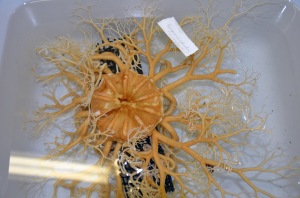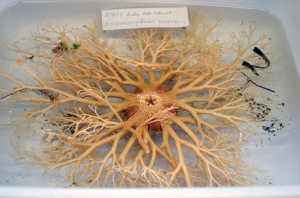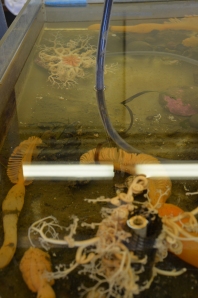Figure 1. Aboral view of Gorgonocephalus eucnemis.
Figure 2. Oral view of Gorgonocephalus eucnemis.
Commonly referred to as a basket star, Gorgonocephalus eucnemis (seen in figures 1 and 2) is one of ten recognized species within the genus Gorgonocephalus and the only one currently known to occur in the San Juan Islands. This particular genus has been extremely successful in radiating throughout the world’s oceans, occurring from the Antarctic to the Arctic (figure 4 WoRMS, Stöhr & Hansson 2013). Gorgonocephalus relies on and is characterized by its five bifurcating arms which unlike most ophiuroids, has a skin covering the ossicles. It uses its arms to secure itself on substrate in areas with a strong current, where it suspension feeds. The arms that are acting to feed become curled with a mucus covering at the ends to help capture its prey. In the picture below, it can be observed how this species will strategically position itself in areas of the highest current, even in a small tank.
Figure 3. Two G. eucnemis, 3 located on top of the inflowing water, 1 positioned up current of the outgoing water.
Figure 4. Gorgonocephalus distribution (WoRMS, Stöhr & Hansson 2013)
During my stay at Friday Harbor Labs, I have already had the pleasure to observe three specimens of G. eucnemis (seen in the pictures below) and interestingly enough, each of the three have had distinct morphological differences from one another. While many species of Ophiuroidae are recognized to have high levels of within-species morphological variation, it is truly interesting to observe how visually different these specimens look. I was not able to extend all of the arms properly in the photos without risking damage to the specimens but there is little to no variation in this respect. The main morphological differences between the three specimens lie within the central disc. Figure 5 and 7 both show specimens that have an inflated circular central disc. Figure 6 shows a specimen that is much thinner on the oral-aboral axis and is concave between the 5 main bifurcating arms. All three specimens also exhibit different color patterns of the central disc but color is also known to commonly vary within species of ophiuroids.
Figure 5. Specimen 1, aboral view
Figure 6. Specimen 2, aboral view
 Figure 7. Specimen 3, aboral view
Figure 7. Specimen 3, aboral view
All three specimens were adults and approximately the same size. I hypothesize that the differing shapes of the central disc actually has something to do with the reproductive stage of the 3 specimens. Figure 5 shows a specimen that has a swollen disc but I hypothesize has gametes filling in its reproductive bursae slits. The specimen in figure 6 probably is not reproductively mature or currently producing gametes and the specimen in figure 7 currently has open bursae slits, possessing large masses of eggs. All three specimens, even with morphological differences, key out to G. eucnemis (Bush, 1920). When I get back to Auburn, I will perform a genetic analysis using standard COI and 16S markers on arm clips from all three individuals to test the level of genetic differentiation.
Just for fun, I included a photo of Gorgonocephalus chilensis (1 of the other 10 species from this genus) that was collected in January from the Amundsen Sea, off of Antarctica during our cruise on the RVIB Nathaniel B. Palmer. Notice how similar the physical morphology of the central disc is between this species and G. eucnemis. Morphological differences that can be used to distinguish different species of Gorgonocephalus lies within the spines and skin on the central disc. To be specific, the shape of the spines and where the skin is present or absent, can be used to key out a species. Subtle morphological differences emphasizes the need to combine standard systematicswith genetics to make sure we are being accurate in our assumptions about current biodiversity.
Figure 8. Gorgonocephalus chilensis aboral view
Figure 9. Gorgonocephalus chilensis oral view.
Bush, Mildred. “Key to the echinoderms of Friday Harbor, Washington.”Publications-Puget Sound Biological Station 2 (1920): 17.
Stöhr, S.; Hansson, H. (2013). Gorgonocephalus Leach, 1815. In: Stöhr, S., O’Hara, T. (Eds) (2013). World Ophiuroidea database. Accessed through: World Register of Marine Species at http://www.marinespecies.org/aphia.php?p=taxdeta.
Matthew P. Galaska
Auburn University






